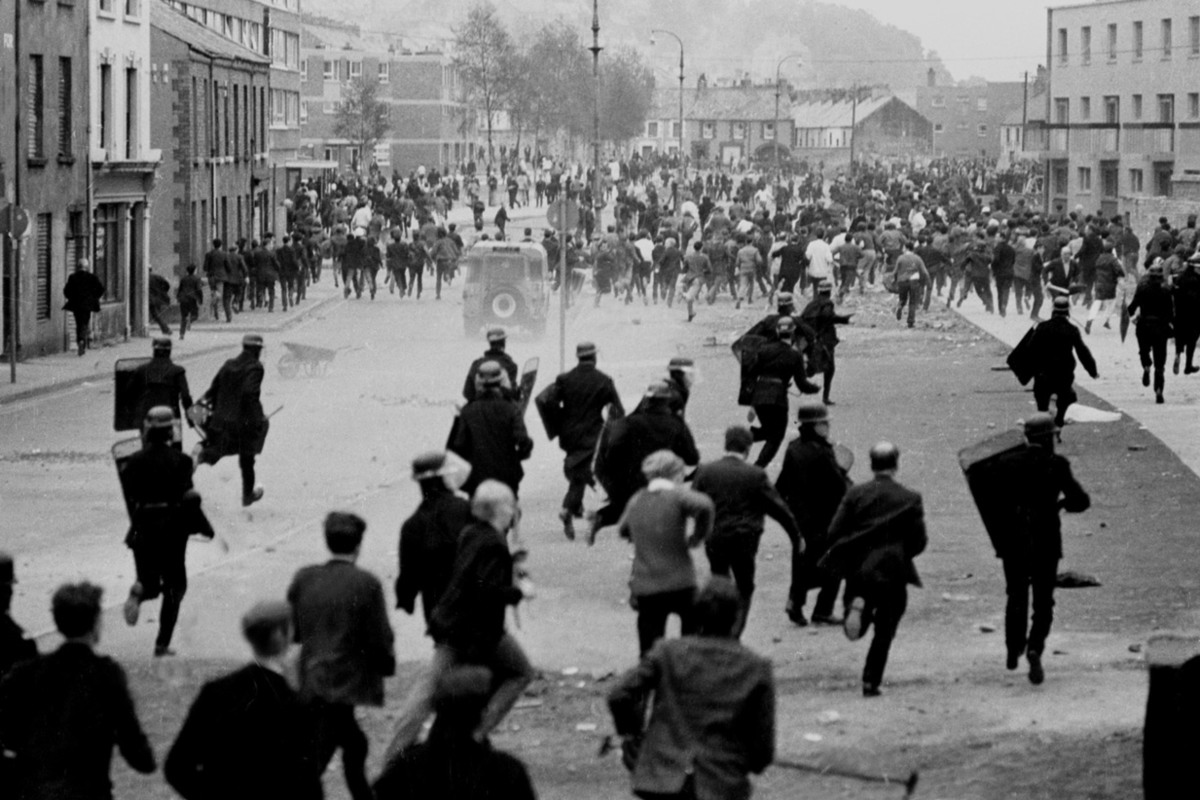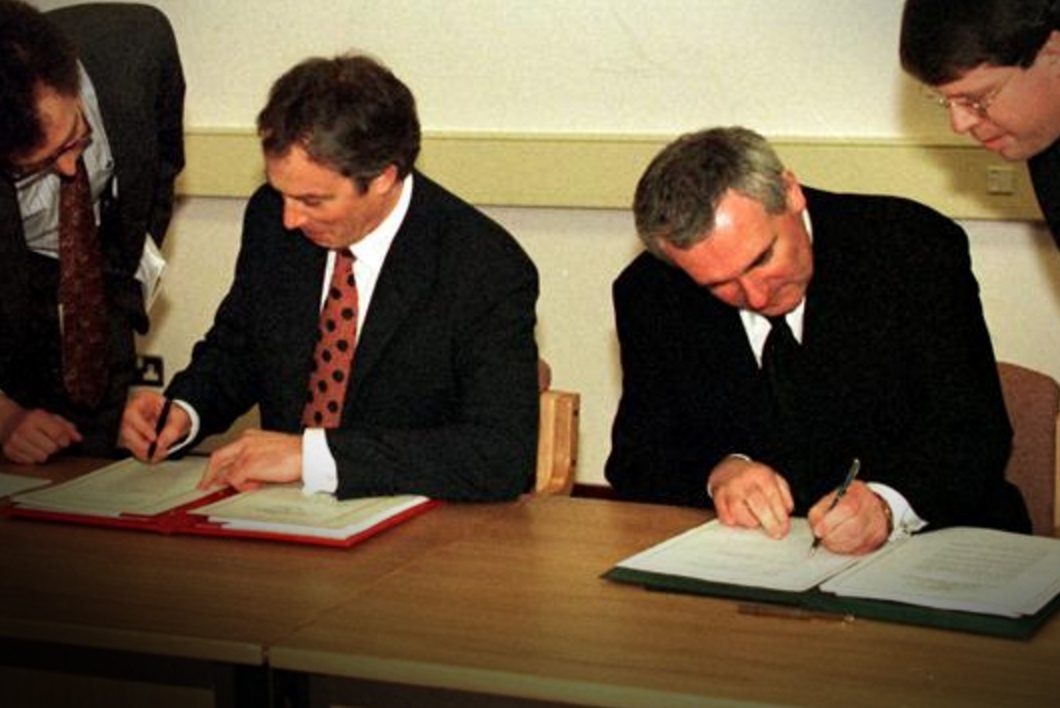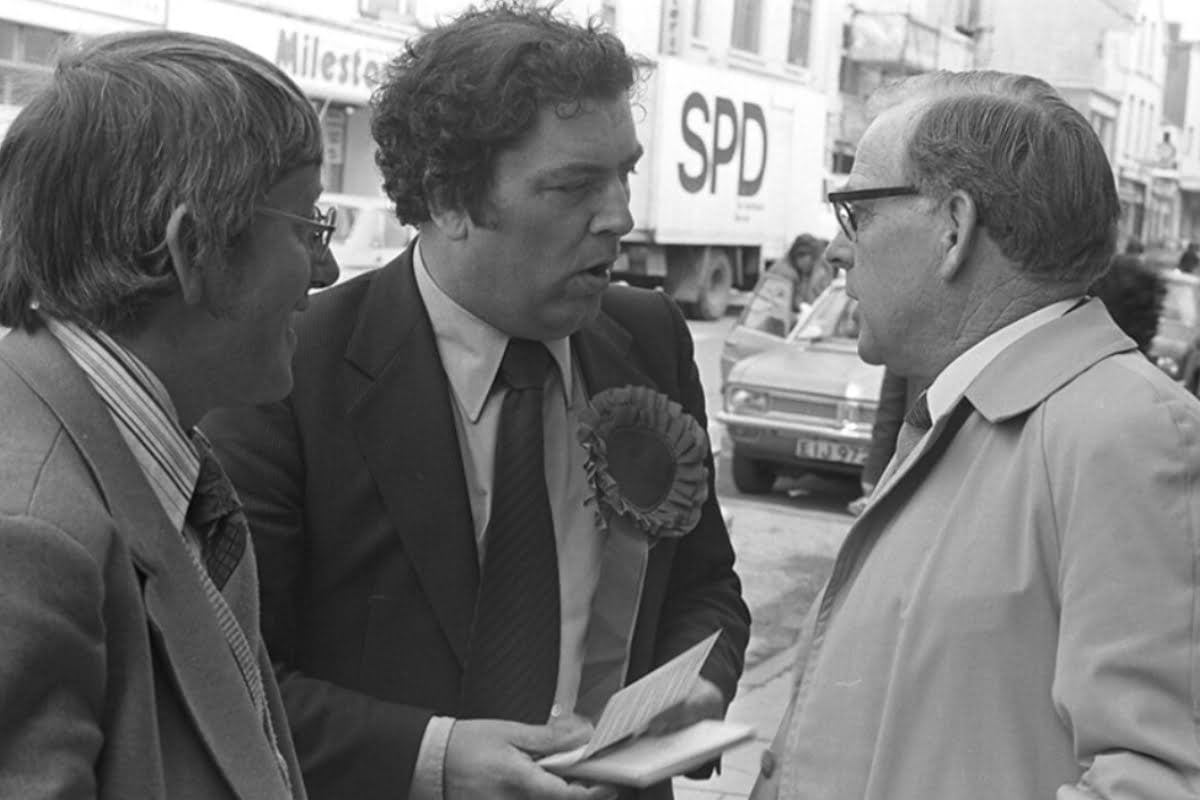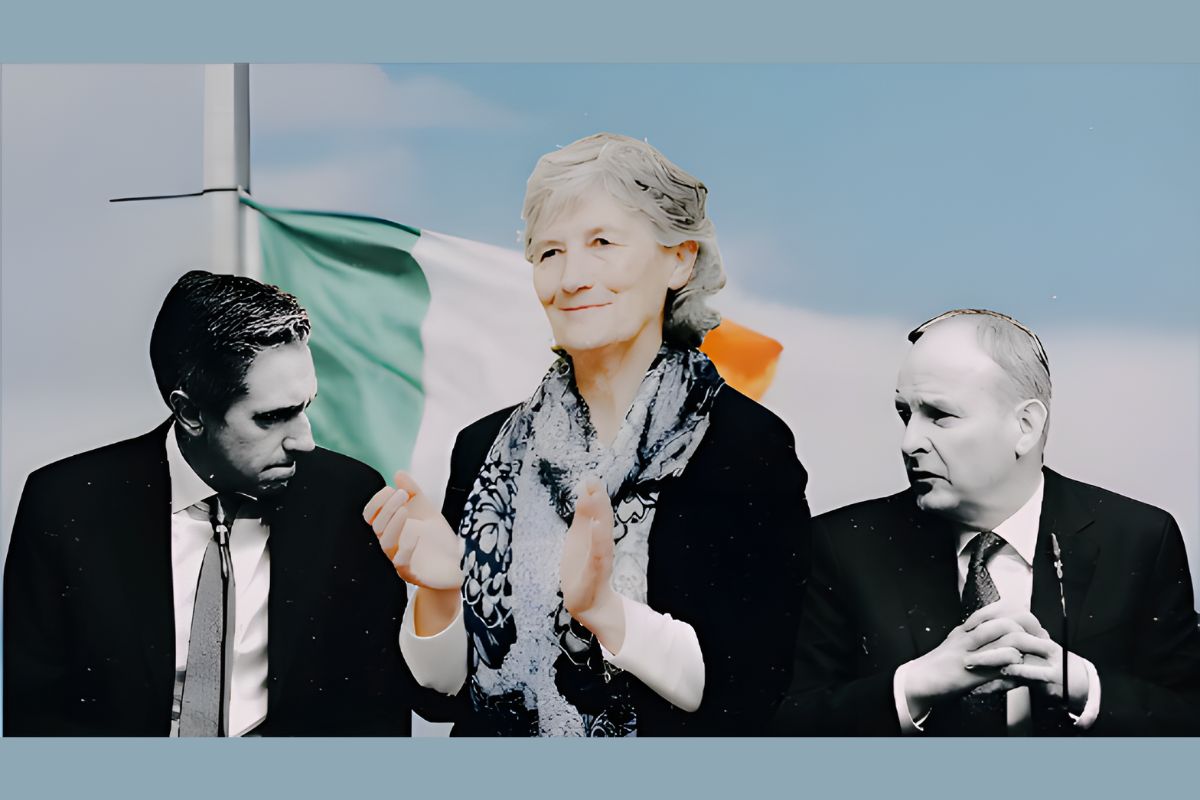John Hume – founding member of the SDLP in the North of Ireland, and key architect of the Good Friday Agreement – died recently, on 3 August. The establishment has been full of posthumous praise. But his lasting legacy has not benefited the working class.
“The history of all hitherto existing society is the history of class struggles.” (The Communist Manifesto)
There are some who find it hard to see class struggle at the bottom of the recent history of the Northern Ireland state from the 1960s on. Some only see a sectarian conflict. But the reality of the class struggle is never so simple as two classes lining up in opposition to each other, ready to fight it out to the death.
British imperialism is a past master at subjugating nations and then creating sectarian divisions within the native population in order to maintain its control. Nevertheless, throughout the past sixty years, the issue of class has always been at the fore in the North.
How did a struggle for civil rights for all citizens end with the creation of a local administration which has institutionalised sectarianism into the very fabric of its parliamentary process? And how did a peace process cement ever more “peace walls” and reinforce the segregated character of northern society? Only by looking at the history of the North through the lens of class struggle can we really understand how we arrived at where we are today.
Who benefited from the 1998 Good Friday Agreement? Is the protestant working class better off as a result? Is the nationalist working class better off as a result? Is the working class as a whole better off? Economically, politically and culturally they are worse off.
Only by the absence of violence have workers benefited. Neither the late John Hume nor Gerry Adams are sectarian in themselves. But the end of their endeavours has been to create a frozen, divided society that hinders social and personal development.
Gushing praise
The recent death of John Hume has seen an outpouring of praise for his achievements, his personal courage and his single-minded approach to the North’s problems. Media coverage was almost universally full of praise.World leaders were effusive about his achievements.
In remembrance of John Hume. My thoughts are with Pat and all the family as John makes his final journey home. He will be greatly missed – Tony Blair#JohnsLight pic.twitter.com/br6GgEWRFx
— Tony Blair Institute (@InstituteGC) August 4, 2020
Even the Sunday Independent, the mouthpiece of the Southern ruling class, which had demonised John Hume with negative and personal insults for his involvement in talks with Gerry Adams in the 1980s and early 1990s, was forced to acknowledge that it had got it wrong and history had proved Hume right.
Ed McCann, Deputy Publisher at Independent News & Media, said, “the paper went too far in its attacks on Hume and some of its coverage seemed to have a vindictive nastiness that undermined genuine concerns.” He described, “an undercurrent of antipathy towards northern nationalism of whatever hue” (Sunday Independent, 9/8/20)
Indeed, the Sunday Independent was and remains the voice of those in both the British and Irish establishments whose only concern is the maintenance of the status quo. From 1968 onwards, the crisis in the North, the mass mobilisation of the nationalist working class, and the subsequent armed campaigns rocked the status quo. Hence their blanket hatred towards northern nationalism.
Sinn Féin spokespersons also joined in the chorus of praise for John Hume. Jim Gibney described Hume in the Irish News as, “a peacemaker, who captured the elusive prize of peace ending centuries of resistance to the violent occupation of this country by Britain.”
However, none of the Sinn Féin voices in praise of John Hume mentioned the fact that Republicans had once considered Hume’s assassination. Nor did they mention the many attacks on the homes of elected SDLP members including John Hume, Gerry Fitt and Paddy Devlin in the past by the Provisional IRA and its supporters. Another commentator wrote:
“In the 1960s, his social activism brought discrimination in Northern Ireland to the world stage and united the disparate nationalist politics of the preceding half-century into a single movement.” (Newton Emerson, Irish News 8/8/20)
Needless to say, most of this is simply rubbish. John Hume did not unite the disparate nationalist politics into a single movement. Nor did he capture the prize of peace and end centuries of resistance to the violent occupation of Ireland by Britain.
Conservative outlook
 John Hume was a product of his time. He was influenced by his surroundings, his religion and the sectarian state he grew up in. Both his education and his early occupation as a teacher within the catholic sector influenced his ideas and his outlook. He was naturally conservative.
John Hume was a product of his time. He was influenced by his surroundings, his religion and the sectarian state he grew up in. Both his education and his early occupation as a teacher within the catholic sector influenced his ideas and his outlook. He was naturally conservative.
However, he was not blind to injustice and having been brought up in Derry he was aware of the blights of poverty, emigration, unemployment and discrimination.
Early on he threw his energies into establishing a credit union; he campaigned for the establishment of a new university in Derry City; and he was active in housing and other social issues. In that he was no different from many other activists, other than his essentially conservative background and his gradualist approach.
He was also one of the first generation to benefit from the British welfare system and free further education provisions. As such, he became one of the most articulate representatives of the emerging catholic, middle class in the late sixties and seventies.
Given the dreadful housing conditions in Derry and the blatant discrimination and gerrymandering of the electoral boundaries, many activists in Derry took to the streets to agitate and organise against the system. John Hume even then preferred to lobby than to take direct action. Only when the RUC batonned people off the streets in Derry on 5 October 1968 did Hume’s activities take a more political orientation.
The Northern Ireland Civil Rights Association, which organised the 5 October march that the Unionist government banned, was a broad-based committee representing a multitude of political views, including Republicans, Communist Party members, moderate nationalists, liberal unionists and members of the various labour parties then in existence.
Hume had no part in bringing this committee together. At that time the broad views of the nationalist population were represented (very badly!) by the Nationalist Party under its leader Eddie McAteer. A small pressure group had been set up by more progressive elements, calling itself the National Democratic Party, but they had little electoral experience. They were to play a key part in the later foundation of the Social Democratic and Labour Party (SDLP).
Mass movement
It became clear after the RUC’s brutality on 5 October 1968 that things would never be the same again. The pressure to hold that march had come from left-wing elements in both the Derry Labour Party and the left-wing of the Republican Clubs in Derry.
The very next day the middle-class nationalists in Derry City quickly organised themselves and, with the approval of both the local traders associations and the hierarchy of the Roman Catholic Church, set up a Derry Citizens Action Committee.
Hume was the main influence in this new committee. They had two main objectives: to wrestle control of the new movement then emerging from the leftists and others who they could not control; and to reform the structures of the northern state so that nationalists could share in the benefits of power and be treated equally.
However, it is never easy to control a mass movement. Over the period of the following three years, the northern nationalist minority forcefully took to the streets. A political struggle for control of this movement took place against a backdrop of increasing repression from Unionism and later from the British Army.
There were essentially four main tendencies fighting for control. There were constitutional nationalists who wanted a deal with Unionism and a share in power. Then there were the republicans and members of the official Communists Party who wanted a bill of rights and a reformed Stormont with the possibility of some kind of workers unity.
A third tendency was a left element who saw an opportunity to mobilise the mass of workers both north and south in opposition to two reactionary clerical states. Finally there were militant national/republican groups who saw a new opportunity to rise up against British control of the north with armed force as its primary weapon.
Inevitably, serious differences occurred in the heat of the struggle of the mass movement. There were casualties. The old nationalist party lost all its influence when its leaders advocated accepting the minor concessions of Unionism under the slogan, “Half a loaf is better than no bread.”
Filling the vacuum
Into the vacuum stepped a mixed bag of independents, ex-nationalists, and young civil rights activists from the catholic middle classes, some with a background in labour politics. They formed the SDLP with Gerry Fitt, formerly of the Republican Labour Party, as its nominal leader.
The SDLP was never a coherent party and had no connection with the labour movement, despite its name. It was in essence a socially conservative grouping, representative of the catholic middle classes, who saw socialists and republicans as the enemy.
Fitt moved to the right under the pressures of the escalating violence and eventually lost the seat he held in Belfast. He ended up in the House of Lords, nursing his bruised ego; along with his shunning of the Hunger Strikers, this action earned him the moniker “Gerry the Brit” in some circles. So reviled was he that he had to leave his native Belfast.
Hume took over as leader, but in truth was more of a one-man band than a natural leader. His deputy leader was Seamus Mallon and it would be fair to say they had a prickly relationship at the best of times.
All the attempts to re-establish a working northern government, after Stormont was abolished in 1972 failed.
When the British Army murdered people on the streets of Derry in January 1972, it effectively ended the mass movement for civil rights. The more radical sections of the inflamed nationalist working class saw it as the end of politics, and flocked to join the various republican movements which had split over the essential issue of reforming the Northern State or smashing it.
Eventually the Provisional IRA (PIRA), who advocated the smashing of Stormont (the local Northern Ireland Parliament) became the dominant tendency acting on behalf of the “people”. Their economic bombing campaign devastated many towns and villages in the North. Meanwhile, sections of the Unionist leadership flirted with loyalist gangs to unleash sectarian murder on catholics. The attitude being, “any taig will do”. [“Taig” is an offensive term for Catholic.]
With both nationalists and unionists retreating into their respective blocs, the class issues became blurred, apart from a few joint campaigns by the trade union movement against the violence. Socialists faced an uphill battle for influence. Militarism held sway.
‘Ballot box and the bullet’
 John Hume was at one time set to become a priest, studying at Maynooth College. He never escaped his clerical background, spending the whole of the Troubles preaching a pacifist moralism. Such sermons would be well suited to the cloisters and lecture halls of Maynooth. But in the heat of the struggles that rocked Ireland in the 60s and 70s, they offered no real way out.
John Hume was at one time set to become a priest, studying at Maynooth College. He never escaped his clerical background, spending the whole of the Troubles preaching a pacifist moralism. Such sermons would be well suited to the cloisters and lecture halls of Maynooth. But in the heat of the struggles that rocked Ireland in the 60s and 70s, they offered no real way out.
In answer to the 14 dead by the hands of the Parachute regiment in Derry’s Bogside; the 11 dead in Ballymurphy; the hundreds of young men ripped from the arms of their loved ones and taken to internment camps; the decades of discrimination: all Hume could advise was to “turn the other cheek”. Whilst thousands of young Catholics had grasped crucial class lessons from Bloody Sunday, John was still fumbling with his Biblical adages.
Most of the armed groups took it upon themselves to act “on behalf of the people” regardless of what “the people” themselves thought.
The PIRA had, after two truces with the British a new leadership under Gerry Adams devoted to a long war strategy. The two hunger strikes of the early 1980s saw again another influx into their ranks. But more importantly, it saw them gain some electoral advantages in some areas over the isle of Ireland.
Their commitment towards a socialist republic had persuaded some socialists from other parties to join them in the belief that this was the way forward. (Although they should have perhaps listened to Gerry Adams when he said, “there is no Marxist influence within Sinn Féin.”) Their electoral success was a shock for the establishments in Britain and Ireland.
This was the time when the PIRA/Sinn Féin strategy was called the “ballot box and the bullet”. They posed this strategy against Hume’s and the SDLP’s of seeking accommodation within the confines of the Northern state. Indeed, they contemptuously referred to the latter as the “Stoop Down Low Party”.
They believed that armed action and electoral politics would force the British to eventually make a declaration of intent to relinquish the North. There was no thought of mass mobilisation or trying to build alliances with socialist parties or those on the left. For Sinn Féin, the working class were only a passive body to be used. Such a policy had little appeal for those from a unionist background.
But what their supporters and membership did not realise then was that their organisations, both political and military, were heavily infiltrated by British security and that sections of their leadership had established lines of communications with the British establishment over many years.
Pan-nationalist front
Hume, who stood head and shoulders above all the other politicians, had a single-minded determination to bring an end to the violence. Naturally, most of his and the SDLP’s condemnation was of republican and loyalist violence. They regarded the police and security forces as legitimate.
Hume’s main strength was in lobbying. His recurring speech, referred to as “the single transferable speech”, included the phrase, “you can not eat a flag”. But eventually it began to impact. Elected to the European Parliament in 1979, his influence spread within Europe and he forged working relationships with the leading political parties in the South of Ireland.
Mindful of the increasing support for Sinn Féin, Hume’s SDLP were pushing for some concessions from the British to prove that constitutional politics worked. The result was the Anglo-Irish Agreement (AIA) of 1985, which gave the Dublin government a consultative role in the internal affairs of the North. Growth in support for Sinn Féin stalled as the SDLP benefited greatly from the AIA.
Despite the continuing armed struggle, it became clear to the leadership of the republicans that a change of direction was needed. Adams had begun to talk about a “pan-nationalist front”, encouraged by clerical intermediaries and elements close to Charlie Haughey, then leader of Fianna Fáil. Any internal dissent such an approach raised was quickly stifled by Adams.
In proposing a pan-nationalist front Adams was ditching the fundamental republican belief, in Wolfe Tone’s words of “uniting Protestant, Catholic and Dissenter under the common name of Irishmen”, as he instead allied his movement with the reactionary southern ruling class.
In 1986, through intermediaries, messages were sent between Adams and Tom King, then the British Northern Secretary of State for the North. In his response to Adams, King wrote:
“The British government has no political, military, strategic or economic interest in staying in Ireland or in the exercise of authority there that could transcend respect for the wishes of the majority in Northern Ireland.”
Good Friday Agreement
 Thus began a process which ended up with the secret talks between Adams and Hume. As such, from 1986 began the slow torturous talks process culminating in the Good Friday Agreement in 1998.
Thus began a process which ended up with the secret talks between Adams and Hume. As such, from 1986 began the slow torturous talks process culminating in the Good Friday Agreement in 1998.
In the early days, when knowledge of the talks leaked out, the response was universally hostile and the attacks on Hume were brutal. He was “giving cover to terrorists” whose voices could not even be heard in the media. Even his own party colleagues expressed doubts as to the wisdom of talking to Adams while the ongoing violence took on an ever more sectarian nature. But Hume persisted, even at the cost of his own health.
Eventually his persistence paid off. The ruling elites began to see the benefit of having Sinn Féin inside the tent rather than outside. Sinn Féin themselves were desperate to be inside that tent. Using his influence on Irish Americans, Hume managed to secure the granting of a visa for Adams to visit the USA. The road to a ceasefire was now mostly secured.
A process of talks eventually culminated in the Good Friday Agreement and the establishment of a local administration based on power sharing, with weak and vague commitments to equality and reform of the police and the legal system.
Hume had achieved his ambition of peace. But already at that time of his perceived greatest triumph, he suffered a debilitating illness that lingered for 20 years, culminating in his death.
Hume articulated the interests of the catholic middle classes. The representatives of international capital saw Hume as a safe pair of hands. His struggle for equality within the parameters of the six counties, with an external role for Dublin, posed no threat to capitalism. Indeed, when the ceasefire eventually came about, billions of pounds were poured into the North from both the USA and Europe to help cement the peace process.
Hollowness of pacifism
Hume has been compared to the likes of Daniel O’Connell, “the Liberator”, since his death. This is perhaps more fitting than commentators would think. Like Hume, O’Connell was bound hand and foot to the Catholic Church. Like Hume, O’Connell enjoyed a cosy relationship with the British government; and like Hume, he represented the Catholic middle class.
In his seminal work, Labour in Irish History, James Connolly titled his Chapter on O’Connell, “A Chapter of Horrors”. While millions of Irish people died from starvation, O’Connell upheld the inalienable right of landlords to sweat off the labour of tenant farmers. O’Connell argued that change was “not worth the shedding of a single drop of human blood”.
For all this talk of pacifism, it did not stop O’Connell joining the yeomanry to suppress the United Irishmen rebellion. Nor did it stop Hume from encouraging Catholics to join the UDR, the very force which bludgeoned them daily and committed innumerable atrocities. Here we see the hollow nature of this pacifism, which is a condemnation of the oppressed who put up their arm to defend themselves from the blow of the oppressor.
Nevertheless, whilst the violence of the Troubles reigned, Hume and the SDLP enjoyed a certain support from those who looked on in horror. In electoral terms, the ceasefire and the end of the violence therefore gave Sinn Féin a boost to the cost of the SDLP. But Sinn Féin had achieved that electoral success by ditching practically all of its previous policies.
“No return to Stormont”: Gone. “No internal settlement”: Gone. “No recognition of the Dail”: Gone. “No decommissioning of weapons”: Gone. In justifying this they have gone as far as to argue that the armed struggle had nothing to do with a united Ireland but was rather for “equality”, which has become Sinn Féin’s new mantra.
These are only some of the somersaults that Sinn Féin have performed since the talks process with John Hume began over thirty years ago. The end result of the armed struggle was achievement of much the same thing as Hume and the SDLP had achieved in 1973: a power-sharing administration with an all-Ireland dimension, brought down by a loyalist strike. All the sacrifices! All that division: in vain!
We can safely say, therefore, that John Hume’s greatest “achievement” was to convert Gerry Adams’s Sinn Féin into the new SDLP. As George Orwell commented in Animal Farm:
“The animals, watching through the window, realise with a start that, as they look around the room of the farmhouse, they can no longer distinguish which of the card-players are pigs and which are human beings.”






